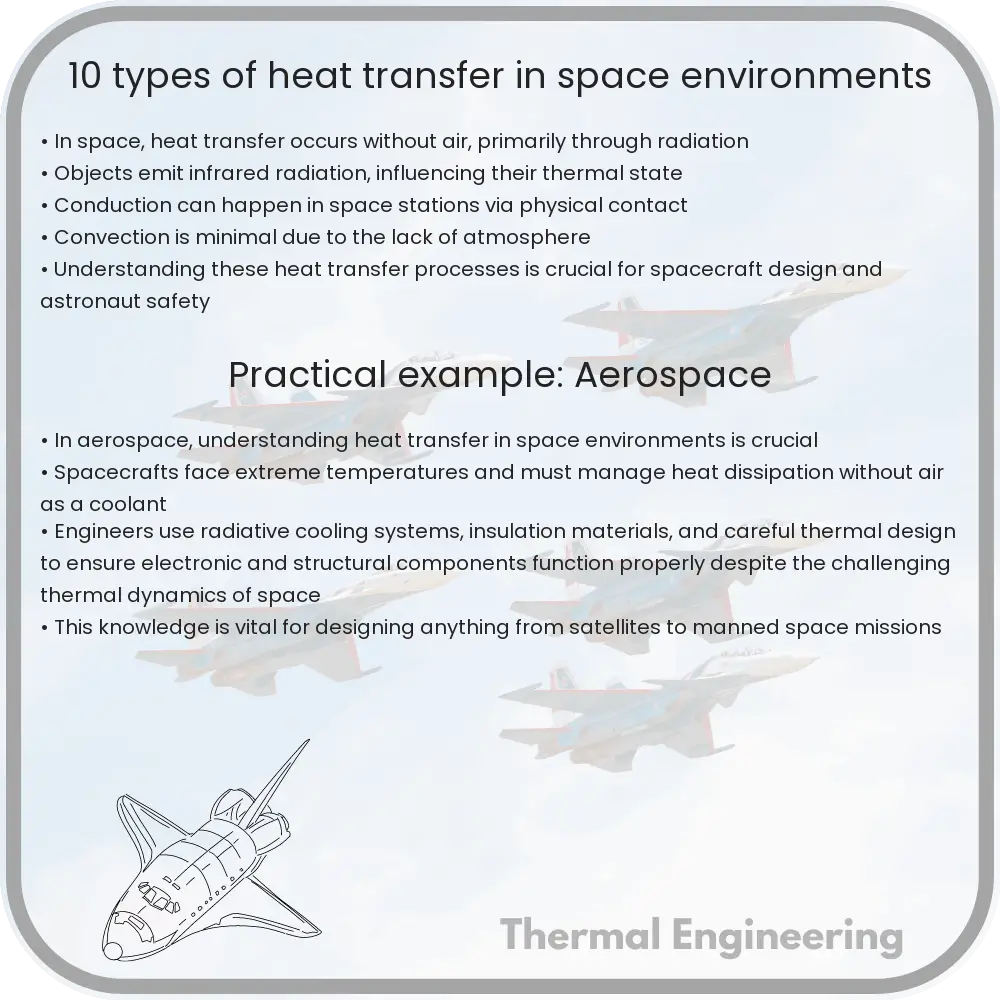Explore 10 heat transfer mechanisms essential for spacecraft thermal management in space environments, focusing on radiation, solar heating, and more.

Understanding Heat Transfer in Space Environments
Heat transfer in space is a critical area of study, particularly in aerospace engineering, where understanding the thermal management of spacecraft and satellites is essential for their successful operation. Unlike on Earth, space does not have an atmosphere for convective heat transfer, which influences the design and functionality of space-going hardware. Here, we will explore 10 types of heat transfer mechanisms encountered in space environments.
1. Radiation
Radiation is the primary mode of heat transfer in the void of space. It involves the emission of electromagnetic waves that can travel through the vacuum. Every object at a temperature above absolute zero emits radiation, and the amount of energy emitted is governed by the Stefan-Boltzmann law:
E = σAT4
where E is the radiant energy per unit time, σ is the Stefan-Boltzmann constant, A is the emitting surface area, and T is the absolute temperature in Kelvin.
2. Solar Heating
Solar heating occurs when a spacecraft is directly exposed to the sun. The Sun’s rays can significantly increase the temperature of the spacecraft, requiring engineers to implement protective thermal coatings and heat rejection systems to manage the absorption of solar energy.
3. Albedo Radiation
Albedo radiation refers to the reflection of solar radiation off a planet or moon’s surface that later strikes a spacecraft. This radiation depends on the reflective properties of the celestial body’s surface or atmosphere.
4. Earth Infrared Radiation
Earth-based infrared radiation is significant for low Earth orbit satellites. The Earth absorbs solar energy and re-emits it as infrared radiation, which can increase the thermal load on nearby spacecraft.
5. Electrical Heating
Internal electrical components like processors and battery units generate heat. Managing this heat to avoid overheating and ensure continued function is a major aspect of spacecraft design.
6. Equipment Dissipation
Apart from electrical components, other onboard equipment such as mechanical devices and scientific instruments also dissipate heat during operation, contributing to the heat load inside the spacecraft.
7. Thermal Cycling
Thermal cycling occurs due to the periodic exposure of the spacecraft to different thermal environments, such as moving from the Sun-lit side of a planet into its shadow. This results in expansion and contraction of materials, potentially inducing structural stresses.
8. Conductive Coupling
In space, conductive heat transfer can occur between different parts of the spacecraft that are in physical contact. Engineers use insulation and careful material selection to manage unwanted conductive heat paths.
9. Radiative Coupling
Components within the spacecraft can also exchange heat amongst themselves via radiation. This internal radiative transfer can affect the spacecraft’s thermal equilibrium and requires careful design of the internal layout and surface properties.
10. Evaporative Cooling
Although less common, evaporative cooling can be used in space missions. This process involves the expulsion of heat through the sublimation or evaporation of materials, used in specialized systems like Heat Rejection Systems in some advanced spacecraft.
Each of these heat transfer modes poses unique challenges in the design and operation of spacecraft. Effective thermal management ensures the reliability and longevity of space missions, protecting equipment from extreme temperature changes and enabling normal operation in the harsh environment of space.